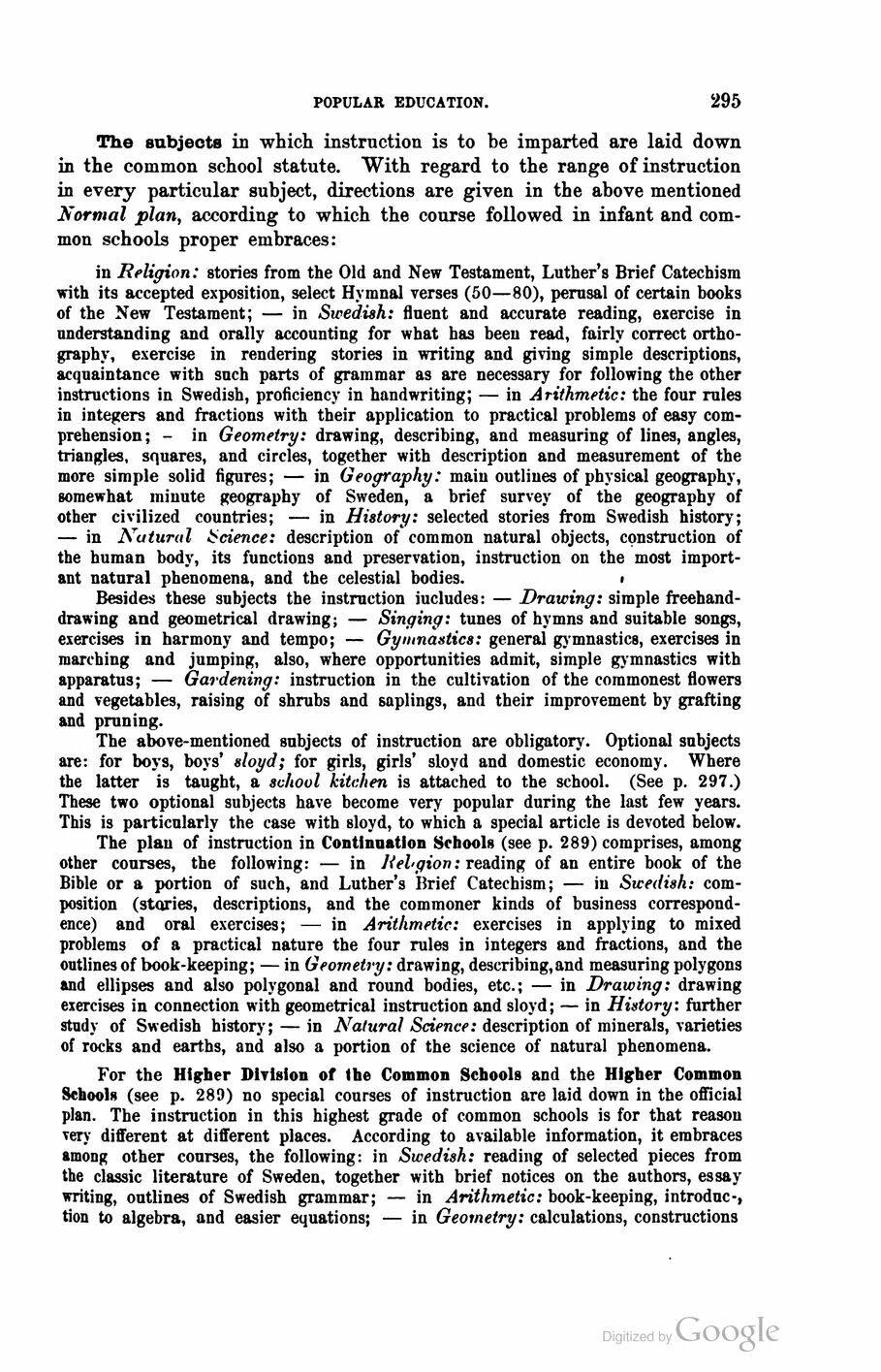
Full resolution (JPEG) - On this page / på denna sida - First part - IV. Education and Mental Culture - 1. Popular Education - Popular Education in general, by J. M. Ambrosius, Ph. D., Inspector of the Common schools of Gothenburg

<< prev. page << föreg. sida << >> nästa sida >> next page >>
Below is the raw OCR text
from the above scanned image.
Do you see an error? Proofread the page now!
Här nedan syns maskintolkade texten från faksimilbilden ovan.
Ser du något fel? Korrekturläs sidan nu!
This page has never been proofread. / Denna sida har aldrig korrekturlästs.
POPULAR EDUCATION.
295
The subjects in which instruction is to be imparted are laid down
in the common school statute. With regard to the range of instruction
in every particular subject, directions are given in the above mentioned
Normal plan, according to which the course followed in infant and
common schools proper embraces:
in Religion: stories from the Old and New Testament, Luther’s Brief Catechism
with its accepted exposition, select Hymnal verses (50—80), perusal of certain books
of the New Testament; — in Swedish: fluent and accurate reading, exercise in
understanding and orally accounting for what has been read, fairly correct
orthography, exercise in rendering stories in writing and giving simple descriptions,
acquaintance with such parts of grammar as are necessary for following the other
instructions in Swedish, proficiency in handwriting; — in Arithmetic: the four rules
in integers and fractions with their application to practical problems of easy
comprehension; - in Geometry: drawing, describing, and measuring of lines, angles,
triangles, squares, and circles, together with description and measurement of the
more simple solid figures; — in Geography: main outlines of physical geography,
somewhat minute geography of Sweden, a brief survey of the geography of
other civilized countries; — in History: selected stories from Swedish history;
— in Nutural Science: description of common natural objects, construction of
the human body, its functions and preservation, instruction on the most
important natural phenomena, and the celestial bodies. i
Besides these subjects the instruction iucludes: — Drawing: simple
freehand-drawing and geometrical drawing; — Singing: tunes of hymns and suitable songs,
exercises in harmony and tempo; — Gymnastics: general gymnastics, exercises in
marching and jumping, also, where opportunities admit, simple gymnastics with
apparatus; — Gardening: instruction in the cultivation of the commonest flowers
and vegetables, raising of shrubs and saplings, and their improvement by grafting
and pruning.
The above-mentioned subjects of instruction are obligator}’. Optional subjects
are: for boys, boys’ sloyd; for girls, girls’ slovd and domestic economy. Where
the latter is taught, a school kitchen is attached to the school. (See p. 297.)
These two optional subjects have become very popular during the last few years.
This is particularly the ease with sloyd, to which a special article is devoted below.
The plan of instruction in Continuation Schools (see p. 289) comprises, among
other courses, the following: — in Kebgion: reading of an entire book of the
Bible or a portion of such, and Luther’s Brief Catechism; — in Swedish:
composition (stories, descriptions, and the commoner kinds of business
correspondence) and oral exercises; — in Arithmetic: exercises in applying to mixed
problems of a practical nature the four rules in integers and fractions, and the
outlines of book-keeping; — in Geometry: drawing, describing,and measuring polygons
and ellipses and also polygonal and round bodies, etc.; — in Drawing: drawing
exercises in connection with geometrical instruction and sloyd; — in History: further
study of Swedish history; — in Natural Science: description of minerals, varieties
of rocks and earths, and also a portion of the science of natural phenomena.
For the Higher Division of <he Common Schools and the Higher Common
Schools (see p. 289) no special courses of instruction are laid down in the official
plan. The instruction in this highest grade of common schools is for that reason
very different at different places. According to available information, it embraces
among other courses, the following: in Swedish: reading of selected pieces from
the classic literature of Sweden, together with brief notices on the authors, essay
writing, outlines of Swedish grammar; — in Arithmetic: book-keeping, introduc-,
tion to algebra, and easier equations; — in Geometry: calculations, constructions
<< prev. page << föreg. sida << >> nästa sida >> next page >>